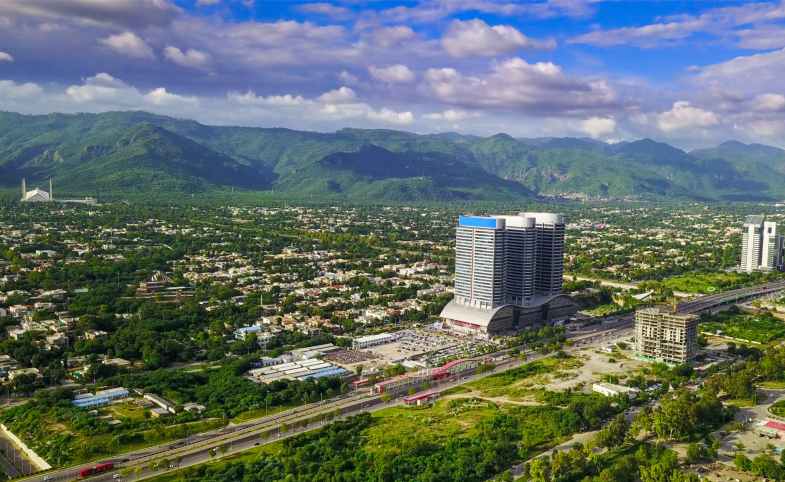The CPD Blog is intended to stimulate dialog among scholars and practitioners from around the world in the public diplomacy sphere. The opinions represented here are the authors' own and do not necessarily reflect CPD's views. For blogger guidelines, click here.

Revisiting U.S. Diplomacy in the Recent Pakistan-India Crisis
When I stepped off the plane at Islamabad International Airport, the air felt different—not heavy with the tension of recent conflict, as I had imagined, but warm with the familiar scent of dust and summer heat, and alive with faces etched with hope and quiet resilience. As I stepped out of the airport, the sun was already draping the Margalla Hills in gold, their jagged edges casting long shadows across the city.
Taxi drivers called out to arriving passengers, porters weaved through the crowd with luggage carts, and families embraced with the joy of reunion. Yet it was impossible to forget that just two months earlier, Islamabad’s name had pulsed through global headlines and crackled across tense diplomatic lines—cast as the epicenter of a looming catastrophe in South Asia. Now, it greeted me with calm in the air and peace on its face, as life moved on, the storm leaving no shadow in its wake.
This time, my return to my hometown carried a different weight. It wasn’t merely about indulging in the sweetness of mangoes, sharing late-night chai with old friends, or catching up with family. Alongside reviving old memories, I was driven by a deeper curiosity to see how the recent crisis between Pakistan and India was perceived on the ground, in the everyday rhythms of life, and in the quiet spaces between headlines. The wheels began turning in my mind: how does an ordinary person make sense of war when its battles are fought not by marching armies, but by drones in the sky and invisible strikes in cyberspace?
This was not a conflict confined to traditional frontlines or framed in newsroom narratives. It had seeped into the digital realm, pulsed through diplomatic back channels, and echoed in shifting public perceptions of what war even means in the 21st century. I came seeking the ground truth and what I found surprised me.
From my vantage point in Washington, D.C., the 2025 Pakistan-India crisis appeared to be a rapidly escalating flashpoint, one that brought the region perilously close to open conflict. Reports of drones breaching airspace, cyberattacks targeting critical infrastructure, and heightened nuclear rhetoric painted a picture of a region on the brink. The crisis, viewed through Western media and policy briefings, felt like a ticking time bomb. As the BBC starkly put it at the height of the standoff, “The world’s first drone war between nuclear-armed neighbors has erupted in South Asia.”
Yet upon arriving in Islamabad, the contrast was striking. I had expected conversations dominated by the specter of war, stories of drone attacks, anxieties over escalation, and debates about Pakistan’s shifting military image. Instead, the chats centered on inflation, economic hardship, the aftermath of floods, the creeping toll of climate change, domestic political drama, and the fervor surrounding Imran Khan’s release from prison. In cafes, markets, and living rooms, people weren’t debating drones or cyberwarfare. They were dissecting judicial conspiracies, lamenting the economy, questioning the rule of law, and trying to make sense of climate chaos. The return of a populist phoenix had gripped the imagination of the people far more than the threat of another cross-border flare-up.
The absence of visible tension or collective fear stood in sharp relief against the alarm that had echoed through international corridors. It was not denial, but rather a kind of resilience or perhaps fatigue born of decades spent living under the constant shadow of geopolitical volatility.
You’d think a brush with nuclear confrontation would hang in the air like monsoon humidity—heavy, inescapable, and slow to lift. But in Islamabad, the war talk had already evaporated. The crisis that had kept me up all nights in Washington, refreshing news feeds, parsing war maps, analyzing military escalations had barely left a ripple in local conversations. It was as if the entire episode had been a film watched, applauded, and forgotten before the credits even finished rolling.
What does this all mean? Perhaps it tells us something about the resilience and the selective memory of nations caught in perpetual cycles of crisis. Or maybe it shows that, in the age of digital desensitization, even near-apocalyptic events must compete with the dramas of daily life for airtime.
As a researcher focused on South Asia’s security dynamics, I had arrived to explore a fundamental question: does war shape domestic realities, or do domestic realities shape the way war is perceived and perhaps even waged?
From what I observed in the capital of Pakistan, the answer leaned toward the latter. Domestic realities, economic pressures, political upheaval, environmental crises seemed to act as a filter, muting the urgency of the recent conflict in the public mind. The war, with its drones and cyberattacks, was not dismissed outright but absorbed into a wider tapestry of everyday concerns. For many, the immediate battle was not on the border or in the digital sphere, but in the marketplace, in the courts, and in the struggle to rebuild after floods. In this way, the perception of war was shaped less by its strategic stakes and more by how it intersected or failed to intersect with daily life.
My journalist friends were a rare exception. During conversations over chai, they spoke of cyber operations, back-channel diplomacy, and the digital Cold War brewing in the region. To them, the crisis was very much alive just submerged beneath a surface of public fatigue and everyday struggles. Their conversations pulled me back into the larger strategic picture, where perceptions on the ground intertwined with the evolving role of U.S. diplomacy in steering the 2025 Pakistan-India standoff away from open conflict.
And then came the bizarre twist: BBC reported the Pakistani government’s decision to nominate then-President Donald Trump for the Nobel Peace Prize. Officially, it was framed as gratitude for his role in de-escalating the standoff, a gesture that, in Pakistan’s intellectual circles, raised more eyebrows than applause. A former ambassador and seasoned journalists were quick to question the wisdom, if not outright absurdity, of rewarding Trump’s so-called “peace through strength” doctrine viewed by many as little more than coercion draped in the language of diplomacy.
"As a researcher focused on South Asia’s security dynamics, I had arrived to explore a fundamental question: does war shape domestic realities, or do domestic realities shape the way war is perceived and perhaps even waged?"
Yet even as the nomination was met with skepticism, there was a broader recognition that U.S. diplomacy beyond the theatrics of a peace prize had played a stabilizing role. Many credited Washington with helping to prevent further escalation and nudging two nuclear-armed neighbors toward dialogue. This, in itself, marked a subtle but significant shift in how American engagement is perceived in South Asia: less as heavy-handed interference, and more as a pragmatic force for de-escalation in moments of high-stakes tension.
In the past, U.S. interventions in South Asia tended to be reactive, and often perceived by Pakistanis as either biased toward India or motivated purely by American self-interest. Whether it was the uneven application of sanctions following nuclear tests in 1998 or the silence around human rights issues in Kashmir, many Pakistanis have seen U.S. diplomacy as selective and unreliable.
But this time, the response felt different. The 2025 crisis offered a rare example of U.S. diplomacy acting as a stabilizer without overwhelming the process. It was measured, behind-the-scenes, and most importantly, multilateral. Rather than acting unilaterally or publicly posturing, Washington worked through regional partners and prioritized de-escalation over dominance.
Drawing on ground-level insights, I argue that what may appear to some as a modest diplomatic intervention was, in fact, a quietly recalibrated approach, one that signals a broader shift in how Washington handles nuclear flashpoints in an age of hybrid warfare.
This is where the metaphor of the kaleidoscope could be applied. U.S. diplomacy in South Asia has rarely been linear. It twists and turns, revealing new colors and forms depending on the moment, the administration, and the interests at play. But in 2025, that shifting pattern aligned briefly but meaningfully into something constructive. It was a moment when the refracted, sometimes contradictory nature of U.S. foreign policy produced clarity instead of confusion.
If Washington can build on this approach sustaining engagement beyond the crisis, investing in long-term regional stability, and showing principled consistency, it may begin to reshape the broader narrative around its role in South Asia. And perhaps then, the kaleidoscope won’t just be a metaphor for unpredictability, but for creative, evolving diplomacy that reflects a deeper understanding of the region it seeks to influence.
Visit CPD's Online Library
Explore CPD's vast online database featuring the latest books, articles, speeches and information on international organizations dedicated to public diplomacy.
POPULAR ARTICLES
-
November 3
-
November 5
-
November 13
-
November 25
-
December 17
Join the Conversation
Interested in contributing to the CPD Blog? We welcome your posts. Read our guidelines and find out how you can submit blogs and photo essays >.









